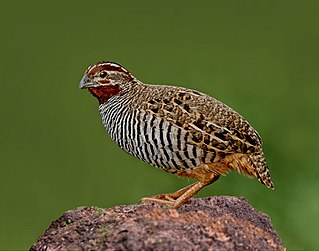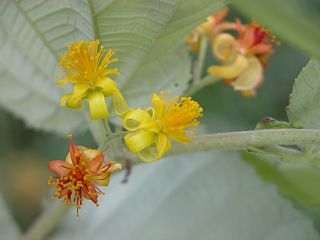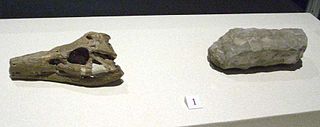
The purple sunbird is a small bird in the sunbird family found mainly in South and Southeast Asia but extending west into parts of the Arabian peninsula. Like other sunbirds they feed mainly on nectar, although they will also take insects, especially when feeding young. They have a fast and direct flight and can take nectar by hovering like a hummingbird but often perch at the base of flowers. The males can appear all black in harsh sunlight but the purple iridescence is visible on closer observation or under good light conditions. Females are olive above and yellowish below.

Taeniasis is an infection within the intestines by adult tapeworms belonging to the genus Taenia. There are generally no or only mild symptoms. Symptoms may occasionally include weight loss or abdominal pain. Segments of tapeworm may be seen in the stool. Complications of pork tapeworm may include cysticercosis.

The jungle bush quail is a species of quail in the family Phasianidae. It is native to the Indian subcontinent, where it is found in peninsular India and Sri Lanka. It has also been reported from Nepal but has not been seen there since the 19th century, and an introduced population exists on the island of Réunion. A small species of quail 15–18 cm (5.9–7.1 in) long and weighing 57–82 g (2.0–2.9 oz), it shows significant sexual dimorphism. Males have brown upperparts with blackish and buff marking and whitish underparts with black barring. The face is mainly dark reddish-brown, with brown ear-coverts, a buffy-white moustachial stripe, and the supercilium turning whitish towards the back of the neck. Females have a similar pattern, but with pinkish-brown underparts, more uniform wings, and duller moustachial stripes.
Asiamericana is a dubious genus of coelurosaur known only from isolated teeth found in the Bissekty Formation of Uzbekhistan. It was named to recognize the occurrence of similar fossil teeth in Central Asia and North America. These regions once formed a connected land mass, during the Cretaceous period.

Centella asiatica, commonly known as Indian pennywort, Asiatic pennywort, spadeleaf, coinwort or gotu kola, is a herbaceous, perennial plant in the flowering plant family Apiaceae. It is native to tropical regions of Africa, Asia, Australia, and islands in the western Pacific Ocean. It is consumed as a culinary vegetable and is used in traditional medicine.

Caudipteridae is an extinct family of oviraptorosaurian dinosaurs known from the Early Cretaceous of China. Found in the Yixian and Jiufotang Formations, the group existed between 125 and 120 million years ago. Distinguishing characteristics of this group have been indicated as including a unique dagger-shaped pygostyle. In 2015, the group was defined as "the most inclusive clade containing Caudipteryx zoui but not Oviraptor philoceratops and Caenagnathus collinsi".

The Cape golden mole is a small, insectivorous mammal of the family Chrysochloridae, the golden moles. The species is a solitary subterranean insectivore, confined to the coastal regions of the southwestern and southern Cape in South Africa. When foraging for small, soil invertebrates and small lizards, these golden moles excavate superficial burrows using their conical nose shield and highly modified forefeet. Females are smaller than males. Golden moles have very dense, soft, and silky coats. The coats are colored blackish to slaty-grey and brown to pale fawn. They have also been observed to venture onto sandy beaches, presumably to feed on amphipods and isopods occurring there.

Grewia asiatica, commonly known as phalsa or falsa, is a species of flowering plant in the mallow family Malvaceae. It was first found in Varanasi, India, and was taken by Buddhist scholars to other Asian countries including Pakistan and the rest of the world. Grewia celtidifolia was initially considered a mere variety of phalsa, but is now recognized as a distinct species.

Barringtonia asiatica is a species of Barringtonia native to mangrove habitats from islands of the Indian Ocean in the west to tropical Asia and islands of the western Pacific Ocean. It is grown along streets for decorative and shade purposes in some parts of India, for instance in some towns on the southeastern shore. It is also known as Box Fruit due to the distinct box-shaped fruit it produces. The local name futu is the source of the name for the Polynesian island Futuna. The type specimen was collected by botanist Pehr Osbeck on a sandy beach area on the island of Java, later to be described by Carl Linnaeus in his Species Plantarum in 1753.

Hsisosuchus is an extinct genus of crocodyliform from China. Currently there are three species within this genus: H. dashanpuensis is from the Middle Jurassic, while H. chungkingensis and H. chowi are from the Late Jurassic. It is likely to have been a medium-sized predator.

Bishanopliosaurus is a genus of plesiosaur. The type species is B. youngi, based on remains found in the Ziliujing Formation of China.

Malus asiatica also known as the Chinese pearleaf crabapple is a species in the genus Malus, in the family Rosaceae. It is native to China and Korea.
Taenia asiatica, commonly known as Asian taenia or Asian tapeworm, is a parasitic tapeworm of humans and pigs. It is one of the three species of Taenia infecting humans and causes taeniasis. Discovered only in 1980s from Taiwan and other East Asian countries as an unusual species, it is so notoriously similar to Taenia saginata, the beef tapeworm, that it was for a time regarded as a slightly different strain. But anomaly arose as the tapeworm is not of cattle origin, but of pigs. Morphological details also showed significant variations, such as presence of rostellar hooks, shorter body, and fewer body segments. The scientific name designated was then Asian T. saginata. But the taxonomic consensus turns out to be that it is a unique species. It was in 1993 that two Korean parasitologists, Keeseon S. Eom and Han Jong Rim, provided the biological bases for classifying it into a separate species. The use of mitochondrial genome sequence and molecular phylogeny in the late 2000s established the taxonomic status.
Shaanbeikannemeyeria is an extinct genus of dicynodont known from the Early Triassic of China. It contains a single species, S. xilougoensis, which was described in 1980 by Zheng-Wu Cheng from a skull catalogued as IGCAGS V315. The specimen was lost, and a neotype skull IVPP V 11674 was later designated. A second species, S. buergondia, was named by Jin-Lin Li in 1980 from a partial skeleton, but it has since been regarded as a synonym of S. xilougoensis.
Ordosiodon is an extinct genus of therocephalian therapsids from the Early Triassic of China. It includes two species, O. lincheyuensis and O. youngi.
Yunnanodon is an extinct genus of tritylodontid mammaliamorphs that lived in China during the Sinemurian stage of the Early Jurassic period. Its specific name brevirostre is Latin for "short-beaked".
Xenolea is a genus of longhorn beetles of the subfamily Lamiinae, containing the following species:
Michael Postel is a French pharmacologist, Buddhist and art collector, known for his contribution of the art collections to Musée Asiatica, a Biarritz-based museum dedicated to Chinese and Indian art. He is the founder president of Franco-Indian Pharmaceuticals, a drug manufacturing company set up in 1949, which has now grown into pharmaceutical conglomerate. Postel, who reached India in 1949 on business related to his pharmaceutical company, started collecting Indian art and, over the years, gathered a collection of over 1,600 pieces. Later, he donated his entire collection to Musee Asiatica. In 2016 the Government of India awarded him the fourth highest civilian honour of the Padma Shri for his contributions to Art.
Acta Linguistica Asiatica is a peer-reviewed academic journal covering research on languages of Asia, their translation and teaching. It is published by Ljubljana University Press.











